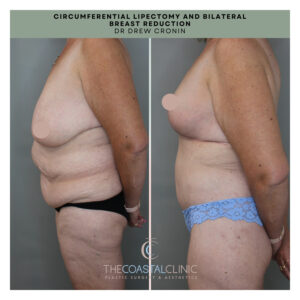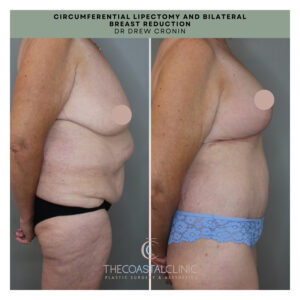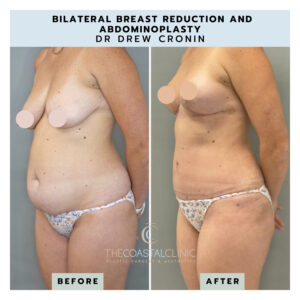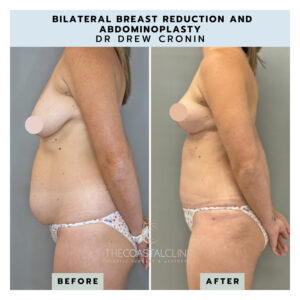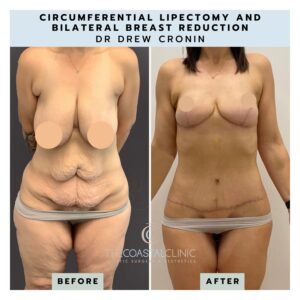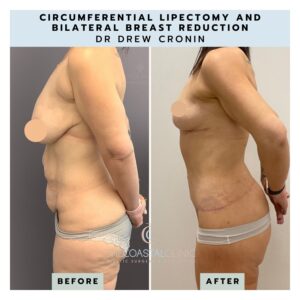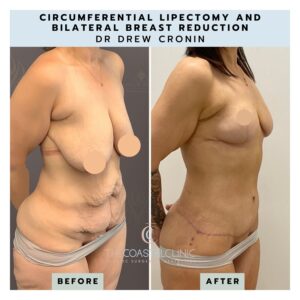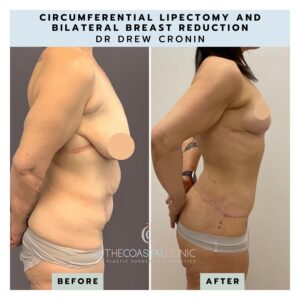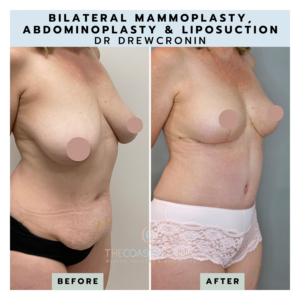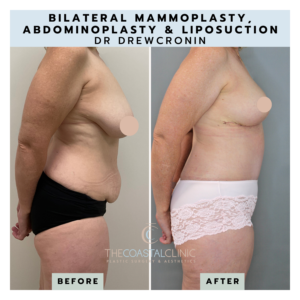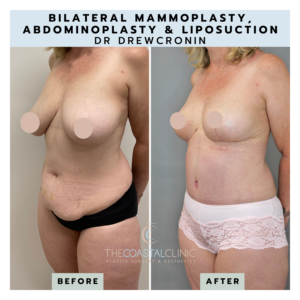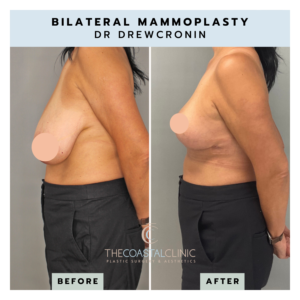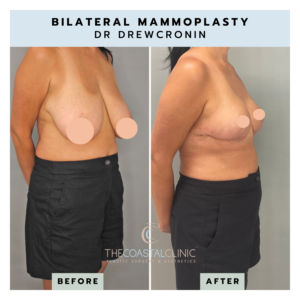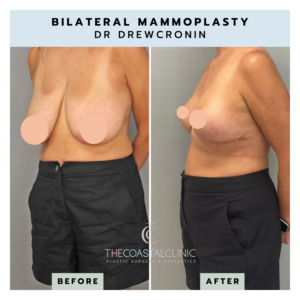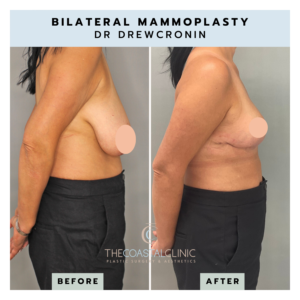
Mammoplasty (Breast Reduction)
A reduction mammoplasty (breast reduction) removes the excess breast weight, whilst reshaping the breast. The breast is lifted higher onto the chest wall, and nipple re-positioned onto the front of the breast.
Women that experience breast ptosis and excess breast volume, may be a candidate for breast reduction surgery.
Who is a good candidate for a breast reduction?

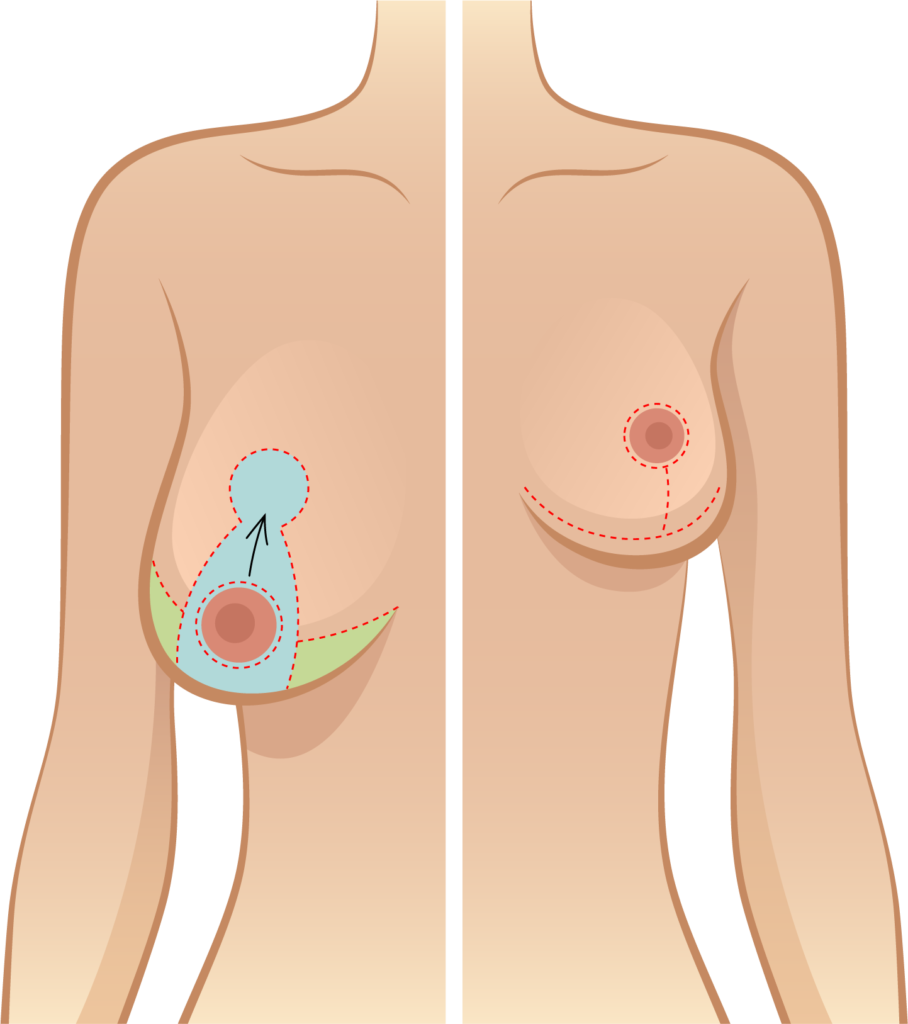
Good candidates for breast reduction surgery are individuals who have:
Experience Pain and discomfort
Posture Issues
Breast Size Disproportion
Indentations from Bra Straps
Stable Weight
Good Overall Health
Benefits of Breast Reduction (mammoplasty) Surgery
Some of the benefits include:
- Reduce neck and back pain
- Reduce skin irritation under the breast
- Reduce sagging in the breast
- Raise the position of nipples and areolas
- Increase mobility and range of movement
- Relieve pain in the breast
- Reduce the size of your areolas
- Make breasts firmer
- Reshape your breast
- Remove breast sagging
- Improved posture
- Enhanced functional capacity for exercise and everyday tasks

How is a breast reduction (mammoplasty) performed?
Anaesthesia
General anaesthesia is used in a certified private hospital.
Incision Patterns
Dr Cronin will make incisions based on the chosen technique discussed, which may include a circular pattern around the areola, a keyhole or racquet-shaped pattern, or anchor-shaped pattern. In most cases the Superomedial Pedicle and Anchor breast scar method is used to perform a reduction mammoplasty (breast reduction).
Tissue Removal and Reshaping
Excess breast tissue, fat, and skin are removed, and the remaining tissue is reshaped to create a smaller, more lifted breast contour.
Nipple Repositioning
The nipple and areola may be repositioned to achieve a natural appearance. In some cases, the areola may be reduced in size.
Closure of Incisions
The incisions are closed with sutures, skin adhesives, and then surgical tape.
Recovery & Aftercare
Patients typically stay in the hospital for a few hours post-surgery and rarely need to stay overnight. Initial recovery time is usually around 1-2weeks.
Discomfort and swelling are common and can be managed with prescribed pain medication after your procedure.
You will have a review with our nurse within your first post-operative week, and each week until your incisions have healed and your pain is resolved. At 6 weeks you will have a post-operative review with Dr Cronin. Regular follow-ups with Dr Cronin at 3months, 6months and 12months are also essential to monitor healing.
Avoid heavy lifting and strenuous activities for at least 4-6 weeks. Light activities can usually be resumed within a few days. Dr Cronin will advise you when it is safe to resume exercise during your 6week review.
Patients are advised on proper scar care techniques to minimise scarring. We offer a scar treatment plan for all of our surgical patients.
The final shape and position of the breasts will settle over several months as swelling subsides.



Breast Reduction Before and After Gallery
Individual results will vary from patient to patient and according to factors including genetics, age, diet, exercise. All invasive surgery carries risk and requires a recovery period and care regime. Be sure you do your research and seek a second opinion from an appropriately qualified Specialist Plastic Surgeon before proceeding. Any details are general in nature and are not intended to be medical advice or constitute a doctor-patient relationship.
For comprehensive information on the potential risks and post-surgery recovery process, please see risks associated with surgery section towards the bottom of this page.
Frequently Asked Questions
If we haven’t addressed your inquiries yet, here are some frequently asked questions that may provide the information you’re looking for. However, if you still have any remaining questions or concerns, please don’t hesitate to reach out to our clinic at 07 5683 0820 or via email at admin@thecoastalclinic.com.au. Our team is ready to assist you.
There are three types of breast implant surfaces available.:
Smooth breast implants have a smooth, non-textured surface. They move feely within the breast pocket and feel very soft. However they have been found to have a higher risk of capsular contracture and rupture.
Nano-textured implants have a very fine, uniform texture created using advanced manufacturing techniques. They are most commonly used by Dr Cronin as the fine texture promotes better tissue integration, helping to stabilise the implant and reduce the likelihood of movement or rotation. There is also a reduced risk of capsular contracture compared to smooth implants.
Textured- Micro textured breast implants have a more pronounced and rougher surface which improves the stability of the implant. Micro-textured implants have also been shown to reduce capsular contracture compared to smooth breast implants. Macro textured implants are no longer available in Australia.
During your consultation with Dr Cronin, he will suggest the most appropriate implant type for you.
There are three types of breast implant surfaces available.:
Smooth breast implants have a smooth, non-textured surface. They move feely within the breast pocket and feel very soft. However they have been found to have a higher risk of capsular contracture and rupture.
Nano-textured implants have a very fine, uniform texture created using advanced manufacturing techniques. They are most commonly used by Dr Cronin as the fine texture promotes better tissue integration, helping to stabilise the implant and reduce the likelihood of movement or rotation. There is also a reduced risk of capsular contracture compared to smooth implants.
Textured- Micro textured breast implants have a more pronounced and rougher surface which improves the stability of the implant. Micro-textured implants have also been shown to reduce capsular contracture compared to smooth breast implants. Macro textured implants are no longer available in Australia.
During your consultation with Dr Cronin, he will suggest the most appropriate implant type for you.
Preparation includes ensuring you are at your goal weight and your weight is stable for at least 3 months.
You will be required to stop smoking or vaping at least 6 weeks before and after your surgery. This is important because smoking and vaping has been shown to significantly affect patient’s post-operative recovery and will potentially compromise your surgical outcome.
Dr Cronin will also advise you during your consultation if you are required to stop certain medications.
Breast reduction (mammoplasty) is a medical procedure and therefore has a medicare item number. To qualify for the medicare rebate, it is a requirement to get a referral from your GP to Dr Cronin and send it through to our clinic email admin@thecoastalclinic.com.au prior to your consult with Dr Cronin.
Before your consultation with Dr Cronin ensure you consider when you would like to have your surgery. You will need to consider:
- When you can take time off work to recover. Allow 1-2weeks (depending on your job)
- Ensure you have adequate support at home to assist if you have children.
- You will also need someone to drive you home and assist you during the initial recovery period. It is a requirement during the first 24hours after your surgery that someone is present at home with you.
During recovery, you may experience swelling, bruising, and discomfort, which can be managed with prescribed medications. You will be provided with a surgical support bra which you are required to wear at all times for at least the first 6 weeks. It is important to follow Dr Cronin’s post-operative care instructions to ensure a smooth recovery.
The duration of breast reduction surgery varies depending on the complexity of the case but typically takes between 2 to 3 hours.
Yes, scars are an inevitable part of breast reduction surgery, however, they typically fade over time. A normal scar usually develops during the first 48 hours after wound closure and can fade between 3 and 12 months with an average time of 7 months.
All patients are offered an add on scar treatment plan.
Mammoplasty has the potential to affect your ability to breastfeed. There is potential for a reduction to your milk supply and nipple sensation.
It’s important to seek the advice of a Specialist Plastic Surgeon, such as Dr Cronin to understand the risks involved in mammoplasty surgery.
The longevity of breast lift results can vary from person to person, as several factors can influence the outcome. While a breast lift can provide long-lasting improvements, it’s important to understand that breasts will continue to age naturally over time.
Other factors that impact the longevity of a breast reduction include aging, weight fluctuations and pregnancy/breastfeeding.
While you will notice an immediate change in the size and shape of your breasts, final results typically take several months to fully appear as swelling subsides and tissues settle. In most cases, by 12 months the breasts have settled into position.
There are three types of breast implant surfaces available.:
Smooth breast implants have a smooth, non-textured surface. They move feely within the breast pocket and feel very soft. However they have been found to have a higher risk of capsular contracture and rupture.
Nano-textured implants have a very fine, uniform texture created using advanced manufacturing techniques. They are most commonly used by Dr Cronin as the fine texture promotes better tissue integration, helping to stabilise the implant and reduce the likelihood of movement or rotation. There is also a reduced risk of capsular contracture compared to smooth implants.
Textured– Micro textured breast implants have a more pronounced and rougher surface which improves the stability of the implant. Micro-textured implants have also been shown to reduce capsular contracture compared to smooth breast implants. Macro textured implants are no longer available in Australia.
During your consultation with Dr Cronin, he will suggest the most appropriate implant type for you.
A detailed will be provided after your consultation with Dr Cronin detailing the costs for the surgical fees, any device, implant and garments used during your procedure and estimated hospital fees. We will provide you with the contact details for the anaesthetist who will provide you with a separate quote for your surgery.
The cost of your procedure includes:
- Dr Cronin’s surgical fees
- Hospital fees (estimate only)
- Two surgical garments
- All post-operative appointments with our Nurse
- All post-operative follow up appointments with Dr Cronin
- Two LED Heallite sessions at The Coastal Clinic Aesthetics located at Varsity Lakes
- A 6week post operative pack which includes the Strataderm
Most patients can return to work within 1 to 2 weeks, depending on the nature of their job and their individual recovery progress. Dr Cronin will discuss this with you during your consultation.
Yes, breast reduction (mammoplasty) surgery can be combined with other procedures. Dr Cronin will discuss your goals during your consultation to determine the best approach for you.
To qualify for the medicare rebate you must have a referral from your GP and you must meet the criteria below. If you are eligible, Medicare will cover some of your surgical fees. You will still incur out of pocket expenses. Dr Cronin will discuss this during your consultation.
Coverage for breast reduction surgery varies by insurance provider. Some may cover the procedure if it is deemed medically necessary due to physical discomfort. Dr Cronin will discuss this with you during your consultation. You will also need to check with your insurance provider for specific details.
Non-surgical options, such as weight loss and physical therapy, may provide some relief but are often insufficient for addressing the discomfort caused by significantly large breasts. Dr Cronin will always discuss any non-surgical options if they are suitable during your consultation.
Risks of Surgery
As part of our commitment to delivering exceptional patient care, we aim to provide you with comprehensive information regarding the general risks associated with surgical procedures, anaesthesia, and procedure-specific risks.
- Acute medical event: Heart or lung complications (e.g. heart attack, stroke, chest infection)
- Death
- Deep Vein Thrombosis (DVT) or Pulmonary Embolisms (PE)
- A sore throat/breathing difficulty due to the general aesthetic or the endotracheal tube, which can cause swelling, noisy breathing or discomfort
- Short-term nausea following general anaesthesia
- Wound infection, which may result in treatment with antibiotics or further treatment/surgery. This is more likely in a smoker or a person with diabetes.
- Heavy bleeding from the wound, which may result in further treatment/surgery
- Wound discharge
- Poor or slow healing of the skin; wound breakdown; skin necrosis
- Wound dehiscence (wound ruptures along the surgical incision)
- Bruising and swelling. This will start to subside in one to two weeks but can take up to several months to settle
- Abscess/Haematoma/Seroma/Oedema
- Pain and discomfort
- Allergic reaction to sutures, dressing, antiseptic solutions
- Altered or loss of sensation in and around the treated area, which may persist for some months, numbness maybe permanent
- Adverse scarring
- Revisionary surgery
- Psychological impact of change in appearance
- Unsatisfactory cosmetic appearance
- Loss of nipple sensation
- Parasthesia (may be numbness or tingling)
- Asymmetry
- Inability to breastfeed
- Pucking at wound edges
- Acute medical event: Heart or lung complications (e.g. heart attack, stroke, chest infection)
- Death
- Deep Vein Thrombosis (DVT) or Pulmonary Embolisms (PE)
- A sore throat/breathing difficulty due to the general aesthetic or the endotracheal tube, which can cause swelling, noisy breathing or discomfort
- Short-term nausea following general anaesthesia
- Wound infection, which may result in treatment with antibiotics or further treatment/surgery. This is more likely in a smoker or a person with diabetes.
- Heavy bleeding from the wound, which may result in further treatment/surgery
- Wound discharge
- Poor or slow healing of the skin; wound breakdown; skin necrosis
- Wound dehiscence (wound ruptures along the surgical incision)
- Bruising and swelling. This will start to subside in one to two weeks but can take up to several months to settle
- Abscess/Haematoma/Seroma/Oedema
- Pain and discomfort
- Allergic reaction to sutures, dressing, antiseptic solutions
- Altered or loss of sensation in and around the treated area, which may persist for some months, numbness maybe permanent
- Adverse scarring
- Revisionary surgery
- Psychological impact of change in appearance
- Unsatisfactory cosmetic appearance





